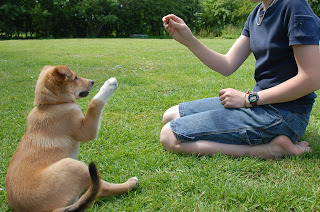 It is an undeniable fact that puppies need to eliminate. The frustrating part is the communication barrier as well as the lack of understanding about where and when it is appropriate to eliminate. Puppies come to us with the simple motto: "If I have to, then I'll do it." This pertains to eating, sleeping (ever see a pup fall over asleep in mid-play?), activity, exploration AND elimination! Puppies do not understand anything more than that. It is up to us to establish a bridge of understanding if they are to live with us harmoniously. We are the ones with all the requirements, not them! They'd be just as happy to take care of their needs the way they already know.
It is an undeniable fact that puppies need to eliminate. The frustrating part is the communication barrier as well as the lack of understanding about where and when it is appropriate to eliminate. Puppies come to us with the simple motto: "If I have to, then I'll do it." This pertains to eating, sleeping (ever see a pup fall over asleep in mid-play?), activity, exploration AND elimination! Puppies do not understand anything more than that. It is up to us to establish a bridge of understanding if they are to live with us harmoniously. We are the ones with all the requirements, not them! They'd be just as happy to take care of their needs the way they already know.The most successful potty training methods consist of four key elements:
1. Confinement
2. Training
3. Timing
4. Praise
This article will discuss them all and also answer common housebreaking questions and address some special cases.
Confinement
Puppies (or dogs who don't yet understand where it is appropriate to eliminate) need to be confined in order to facilitate the easiest potty training. The BEST and most effective place to confine is in a crate or cage (more about crates in an upcoming article). At this point (new introduction to potty training) don't leave anything on the bottom of the crate (blanket, newspaper, etc.). Puppy will make a project out of destroying it. Most dogs do NOT want to eliminate where they live, therefore the crate needs to be just large enough for puppy to turn around and lay down. Anything larger will encourage a puppy to eliminate at one end and sleep in the other. For those puppies who will grow quite a bit larger, use a crate that is sized for an adult and partition it to a smaller size using a homemade insert or a crate insert made by the crate company to fit your crate.
Training and Praise
When I teach a new dog (or puppy) where to eliminate, I ALWAYS use a leash. Leashes keep your dog close to you, where you can supervise and control everything that happens. Puppies, especially, are easily distracted. A blowing leaf, new flower, stick, another animal - all can take a puppy's mind off the matter at hand. If you are near the puppy (or dog) with the leash in hand, a gentle tug will redirect away from the curiosity. Leashes are also good to help teach an AREA to eliminate (behind the garage, etc.). With a leash, you just take the dog there every time.
I also teach words for elimination. This way, when the puppy understands what the words mean, he will understand WHAT I want as well as WHEN I want it to happen. My words are "go potty" for urination and "go poop" for defecation. Your choice can be ANY word or phrase you want to use consistently (such as, "hurry up", "do your business", "get busy", "let's go", "tinkles", etc.). Remember when you choose your word or phrase that you will be repeating it A LOT!
As I take my dog outside on a leash, I start to teach him the word "OUTSIDE". "Let's go OUTSIDE!". "Do you have to go "OUTSIDE"? "OUTSIDE! OUTSIDE!" In time, the dog will learn that the word OUTSIDE is associated with elimination. Eventually you will be able to ask the dog "do you have to go OUTSIDE?" and get a response like barking, running to the door or tail wagging.
Using the Leash & Words to Teach
A slip-type leash is quick and easy to slip on the puppy to take him outside. If the puppy isn't used to the leash yet, slip the leash on and carry the puppy from his crate to outside, saying the entire time "Do you want to go outside? Let's go outside! Outside! Outside! Yay! Outside!". Your emphasis should be on the word "OUTSIDE". Once outside, set puppy down and change your mantra to your word/phrase "Go Potty! Go Potty! Let's Go Potty!". Let puppy sniff and move around a little, but keep him in a general area. Each time he gets distracted (leaf, squirrel, etc.) give the leash a tug and repeat "Go Potty!". The command is generally not said in a firm or angry way and not in a soft or pleading way either - it is usually said in an encouraging tone. When elimination occurs, use a happy tone and repeat "GOOD Go Potty! Yay! Go Potty!". I prefer to use WORDS ONLY to reinforce elimination, because petting or treats can interrupt the act. Verbal praise needs to happen DURING the act, not after! Usually dogs will urinate first, then defecate. You need to become familiar with your dog's habits so you can wait for defecation and use a command for it (i.e.; "more potty", "go poop", etc.).
No comments:
Post a Comment